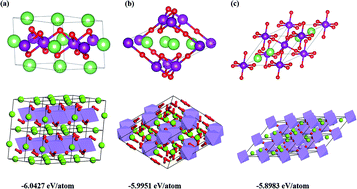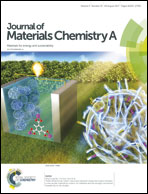New allotropes of Li2MnO3 as cathode materials with better cycling performance predicted in high pressure synthesis†
Abstract
Layered Li2MnO3 as a cathode material is well known for its high lithium storage capacity. However, its poor cycling performance restricts its applications due to surface oxygen release and structural degradation. So it is highly desirable to search for new structures of Li2MnO3 with longer cycle life. In this work using pressure as an effective method in synthesis and global structure search, we find two metastable phases of Li2MnO3 that belong to the space group of C2/C and R![[3 with combining macron]](https://www.rsc.org/images/entities/char_0033_0304.gif) C, respectively. The former one has the following features: a narrow band gap of 0.17 eV, a high open-circuit voltage of >4.4 V, a better structural stability against oxygen release (long cycle-life), a higher reversible capacity than the conventional layered Li2MnO3 phase, appropriate three-dimensional migration energy barriers of 0.45–1.14 eV and enhanced ionic mobility when more vacancies were introduced, while the latter one is metallic with an average open-circuit voltage of 4 V, comparative delithiation ability, and lower migration barriers of 0.10–0.69 eV. Both of them exhibit some merits over the conventional layered phase when used as cathode materials.
C, respectively. The former one has the following features: a narrow band gap of 0.17 eV, a high open-circuit voltage of >4.4 V, a better structural stability against oxygen release (long cycle-life), a higher reversible capacity than the conventional layered Li2MnO3 phase, appropriate three-dimensional migration energy barriers of 0.45–1.14 eV and enhanced ionic mobility when more vacancies were introduced, while the latter one is metallic with an average open-circuit voltage of 4 V, comparative delithiation ability, and lower migration barriers of 0.10–0.69 eV. Both of them exhibit some merits over the conventional layered phase when used as cathode materials.



 Please wait while we load your content...
Please wait while we load your content...